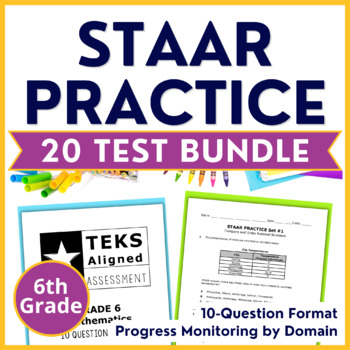6th Grade Math STAAR Practice Bundle - Progress Monitoring by Domain
- Zip
What educators are saying
Products in this Bundle (10)
showing 1-5 of 10 products
Description
Make sure your students are mastering the standards at a rigorous high-stakes testing level. These TEKS & STAAR Aligned 10-Question Assessments are easy to incorporate as quick checks, review, practice, progress monitoring, guided math, intervention, and STAAR test-prep!
These STAAR Practice assessments are grouped by related standards/topics allowing for targeted practice. The 10-question format makes test prep, review, and practice much more manageable!
- ⭐ This resource is now available for Google Drive! IF YOU WOULD PREFER THE NEW GOOGLE VERSION CLICK HERE. The Google version includes BOTH this Original Print Format + a Self-Grading Google Forms Format!
ALL SETS INCLUDED
- Compare & Order Numbers
- Operations
- Ratios, Rates, & Proportional Reasoning
- Percents
- Algebraic Representations
- Expressions & Order of Operations
- Equations & Inequalities
- Geometry & Measurement
- Data Analysis
- Personal Financial Literacy
WHAT'S INCLUDED WITH EACH SET
- 2 assessments per set - 20 different assessments in all
- PDF printable format - Student Test Booklets
- Teacher Answer Key Blueprints
- Student Answer Documents
✅ FOLLOW ME for New Products, Sales, and Freebies!
❤️ I hope this description helps to clarify! If you have any questions or would like to contact me feel free to email me at solanikcurriculum@gmail.com
Terms of Use
Copyright © Catherine Solanik. All rights reserved by the author. This product is to be used by the original downloader only. Copying for more than one teacher, classroom, department, school, or school system is prohibited. This product may not be distributed or displayed digitally for public view. Failure to comply is a copyright infringement and a violation of the Digital Millennium Copyright Act (DMCA). Clipart and elements found in this PDF are copyrighted and cannot be extracted and used outside of this file without permission or license. Intended for classroom and personal use only.





